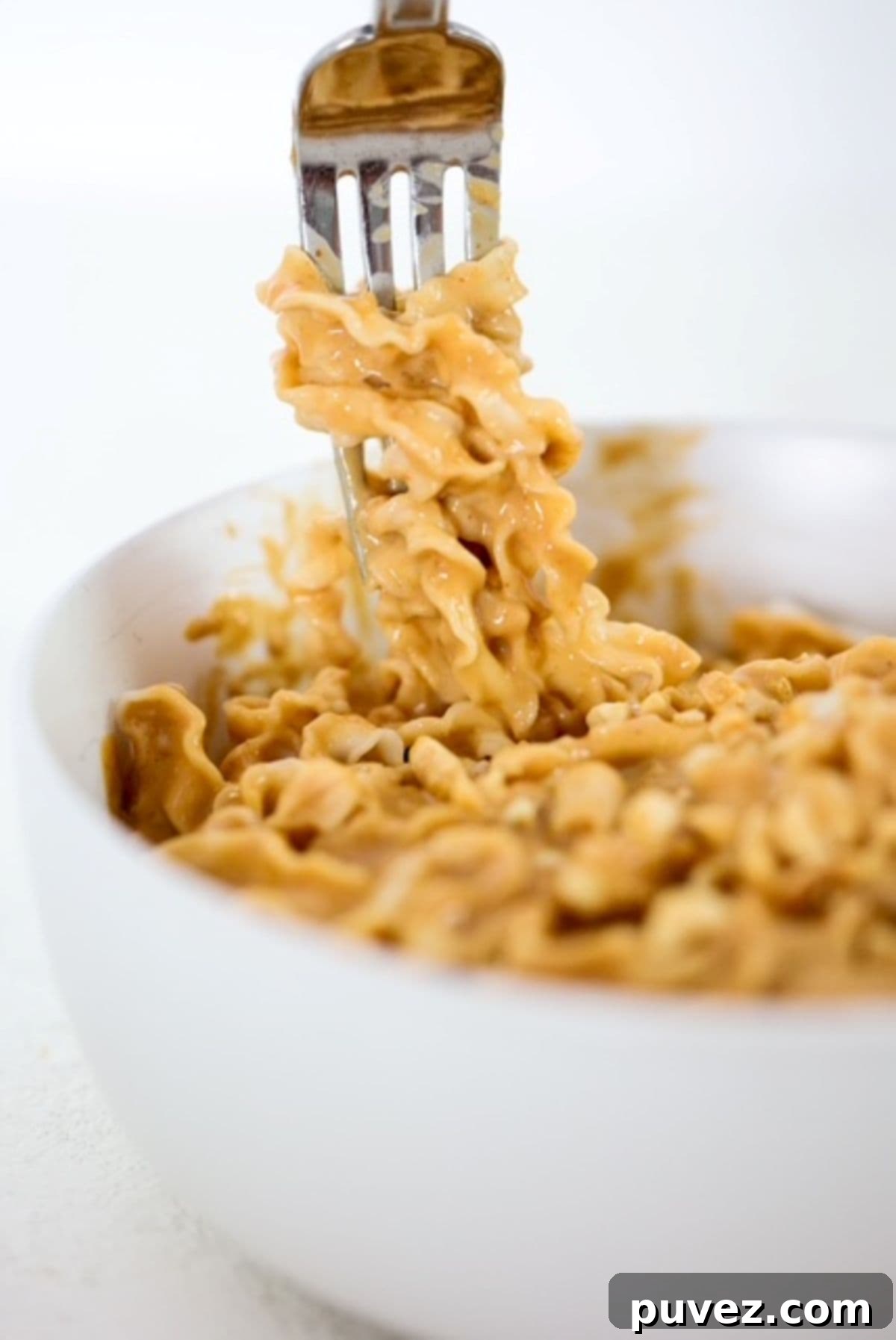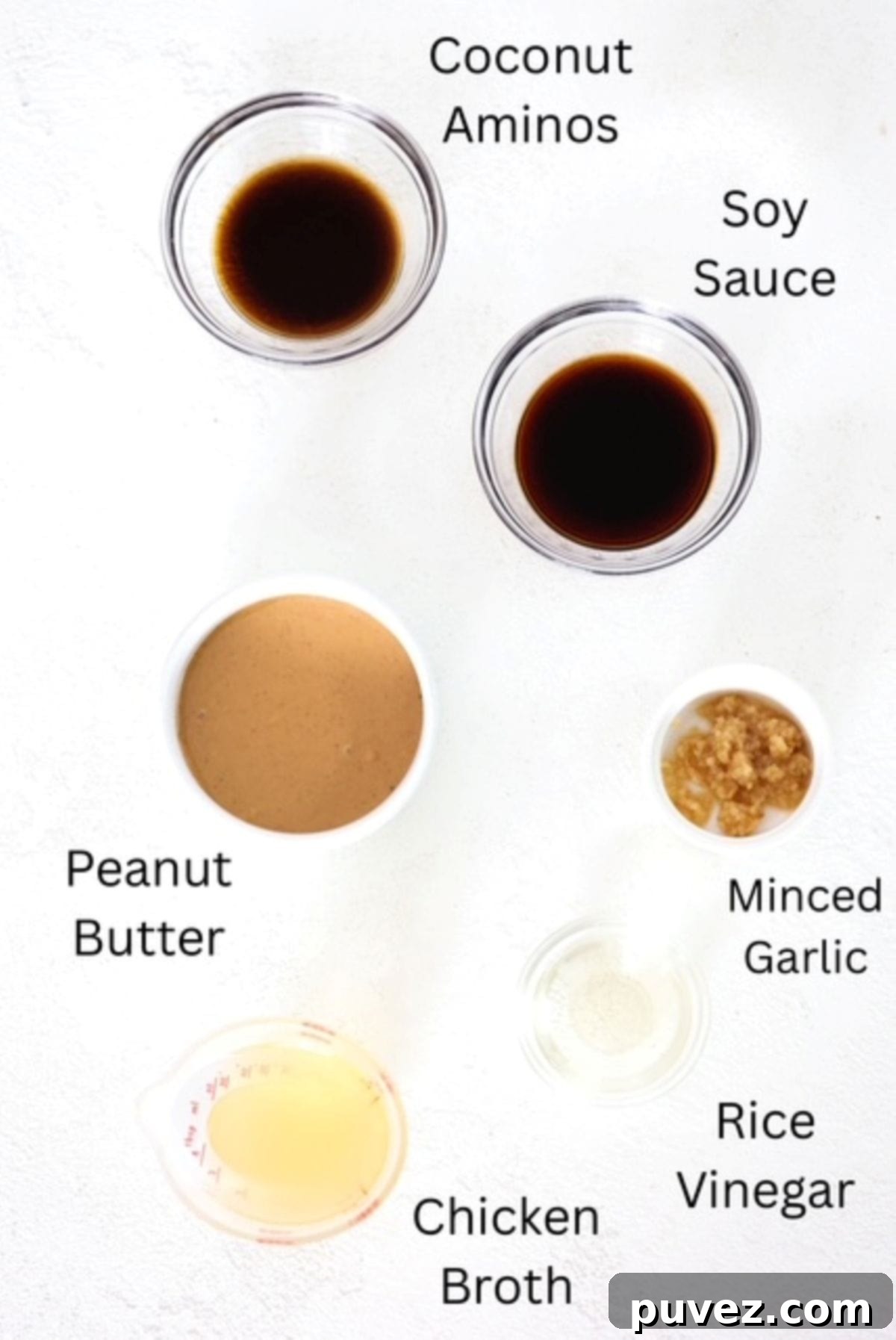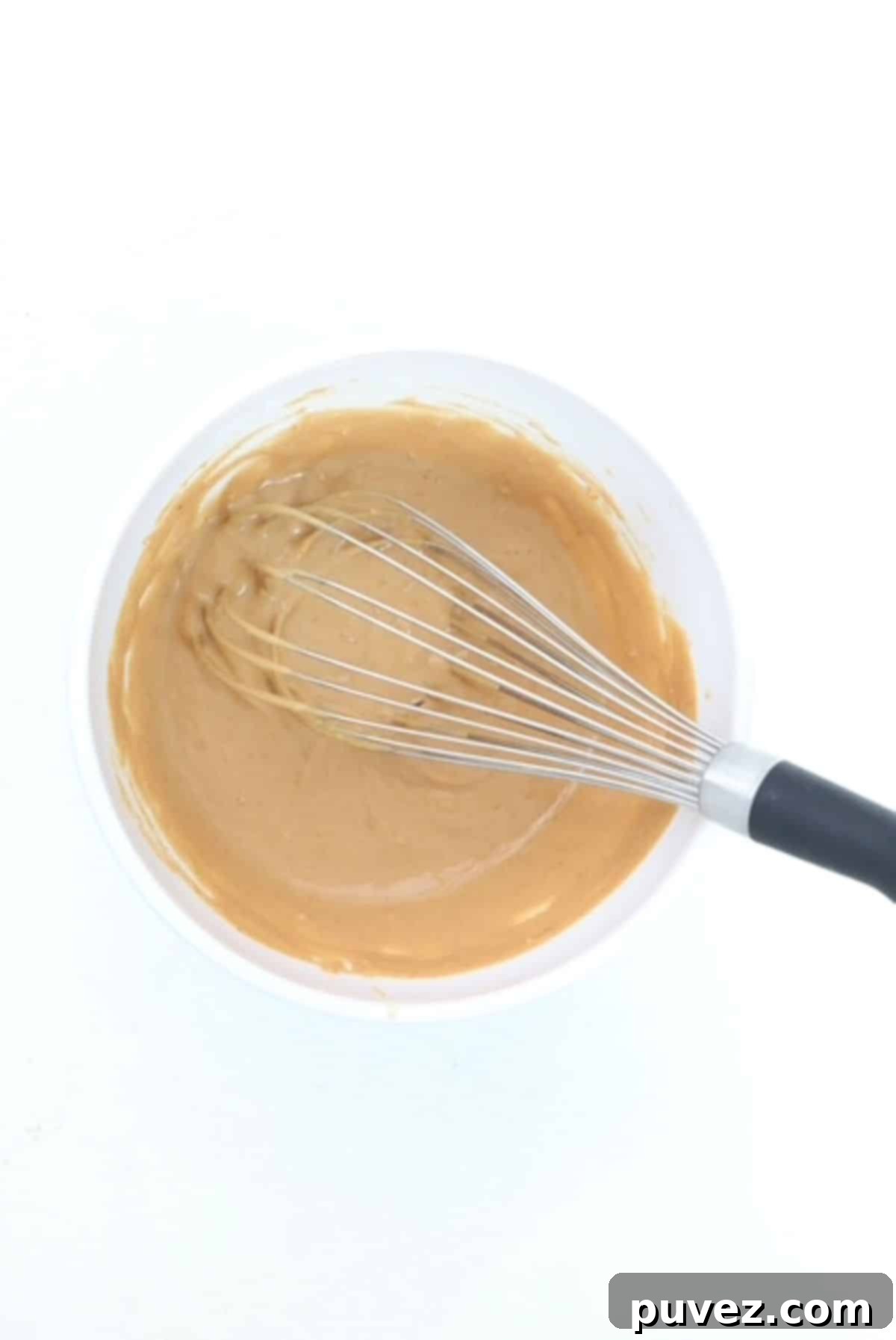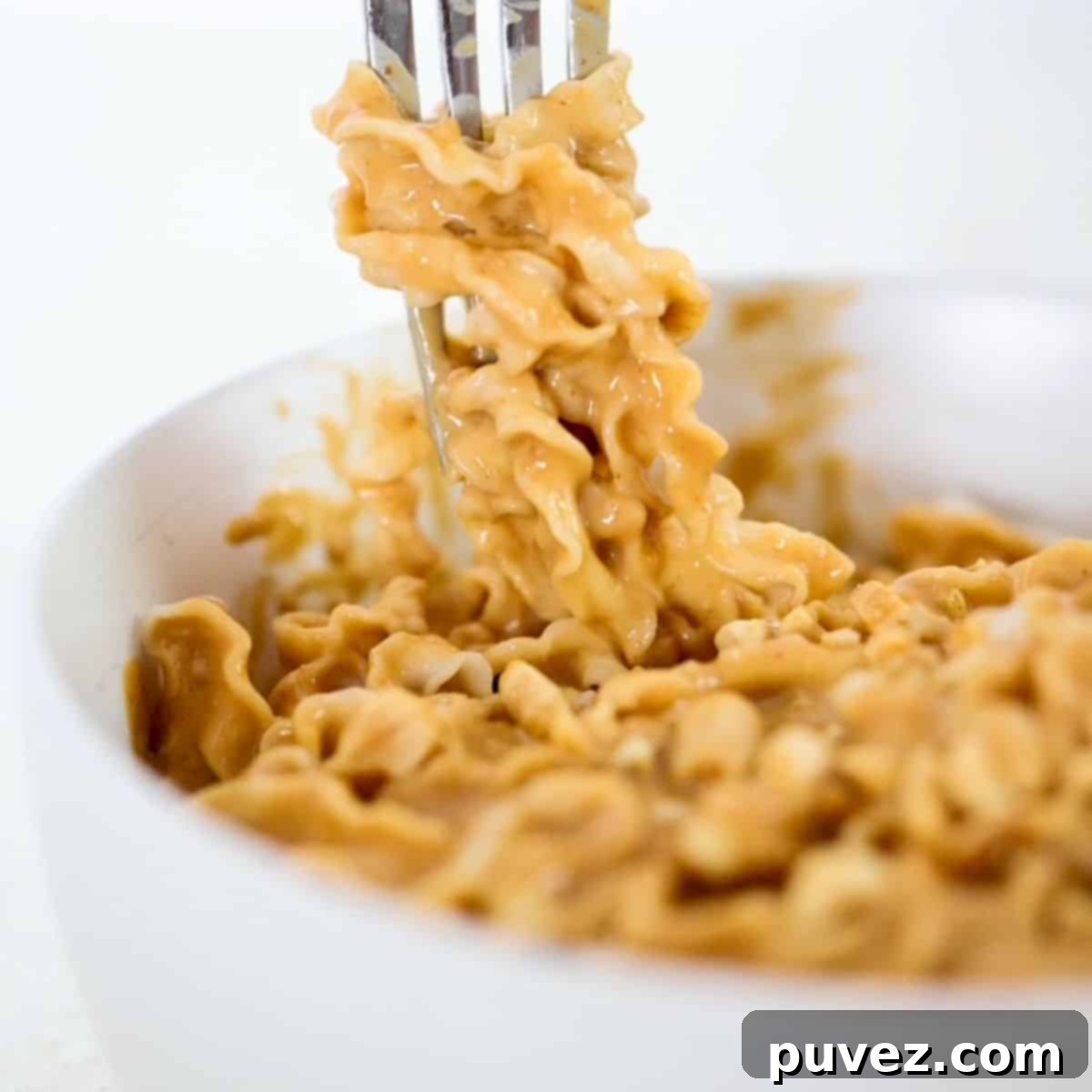Easy & Delicious Peanut Butter Noodles: Your Quick Weeknight Meal Solution
Discover how to make a quick and incredibly easy Peanut Butter Sauce for Noodles right at home. Crafted with simple pantry staples like creamy peanut butter, savory coconut aminos, low-sodium soy sauce, and aromatic garlic, this recipe is your perfect answer for those busy weeknights when you crave something flavorful and satisfying without spending hours in the kitchen.

The inspiration for this delightful peanut butter sauce for pasta struck years ago during a simple lunch break at a hospital cafeteria. It was a revelation! If they could create such a delicious and hearty pasta with peanut sauce so quickly, then surely I could replicate and even improve upon it at home. This simple concept turned into one of my most cherished and frequently made dinners.
This article will guide you through crafting this irresistible peanut butter sauce using just a handful of common pantry items. Beyond the basic recipe, we’ll explore various ways to enhance its flavor and versatility, ensuring it becomes a staple in your culinary repertoire. Whether you’re a seasoned chef or a beginner, you’ll find this recipe incredibly straightforward and rewarding.
Why You’ll Fall in Love with This Peanut Butter Noodle Recipe
This versatile peanut butter sauce is more than just a recipe; it’s a culinary hack that simplifies your meal planning and elevates your weeknight dinners. Here’s why you’ll want to add it to your rotation immediately:
- Effortless & Quick Weeknight Dinner: In today’s fast-paced world, finding a meal that’s both delicious and requires minimal effort is a game-changer. This peanut butter sauce for noodles comes together in minutes, making it an ideal choice for busy evenings when cooking feels like a chore. Forget complicated steps or lengthy cooking times – simply whisk, toss, and enjoy. While it offers a unique flavor profile that differs from traditional Pad Thai, it’s equally satisfying and incredibly filling.
- Utilizes Simple Pantry Staples: Chances are, you already have most of the ingredients for this savory peanut sauce in your pantry. We’re talking about everyday essentials like natural peanut butter, low-sodium soy sauce or coconut aminos, and fresh or minced garlic. These accessible ingredients not only make this recipe incredibly convenient but also prove that extraordinary flavor doesn’t require obscure or expensive items. While you can always experiment with additions like fresh ginger, lime juice, or a dash of sambal oelek for extra heat, the core recipe stands strong on its own, delivering incredible taste without any fuss.
- Excellent for Meal Prepping: One of the greatest benefits of this simple peanut sauce is its suitability for meal prep. You can easily whip up a batch of the sauce the night before, or even at the start of your week. This significantly cuts down on active cooking time later. On a busy day, all you need to do is cook your favorite noodles, quickly sauté some vegetables, add a protein of your choice (chicken, tofu, or shrimp work wonderfully), and then toss everything with your pre-made sauce. This strategy ensures you have a wholesome, homemade meal ready in minutes, saving you time and stress.
- Naturally Sweetened with No Added Sugar: Many Asian-inspired sauces on the market or in recipes rely heavily on added sugars like brown sugar, granulated sugar, or maple syrup. This recipe cleverly bypasses that, utilizing the subtle, natural sweetness of coconut aminos. This not only keeps the sugar content lower but also offers a healthier alternative without compromising on flavor. For an even creamier texture and a touch more sweetness, consider substituting some of the chicken broth with a splash of full-fat coconut milk, adding a luxurious depth to your peanut noodles.
Dietitian Tip
Incorporating peanut butter (or other nutrient-dense nut or seed butters) into your meals and snacks – be it energy bites, smoothies, or delicious sauces like this one – is an effortless way to boost your dietary intake of calories, protein, fiber, and heart-healthy mono-unsaturated fats. It adds a powerful nutritional punch that contributes to satiety and overall well-being.
Key Ingredient Notes for Your Perfect Peanut Sauce
Crafting the best peanut butter sauce starts with understanding the role of each ingredient. Here’s a deeper dive into the components that make this sauce so special:

- Natural Peanut Butter: For the best flavor and texture, opt for natural peanut butter. This type typically contains just peanuts and a small amount of salt, avoiding added sugars and oils. If you prefer a completely smooth and creamy sauce without any small peanut bits, ensure you choose creamy natural peanut butter. If you enjoy a bit of texture, a crunchy variety can also work.
- Garlic: Garlic is a cornerstone of this sauce, providing a robust, savory depth. While fresh minced garlic offers the most vibrant flavor, jarred minced garlic is a convenient and perfectly acceptable substitute. In fact, many find the flavor of jarred minced garlic in sauces to be surprisingly comforting and familiar. Don’t underestimate its power to elevate the entire dish!
- Rice Vinegar: This ingredient is crucial for balancing the richness of the peanut butter. Rice vinegar introduces a subtle, tangy brightness that cuts through the creaminess, preventing the sauce from feeling too heavy. It adds a delightful complexity that is key to the overall flavor profile. You can adjust the amount slightly to suit your preference for tanginess.
- Low-Sodium Soy Sauce or Coconut Aminos: These provide the essential umami and salty notes. Using low-sodium varieties allows you to control the saltiness of your dish more effectively. Coconut aminos is a fantastic soy-free alternative that also adds a touch of natural sweetness, making it a great choice if you’re looking to minimize sodium or avoid soy. The choice between the two depends on your dietary needs and taste preferences.
- Low-Sodium Chicken Broth (or Vegetable Broth): Broth is used to achieve the desired consistency for your sauce. It helps thin out the thick peanut butter, making it smooth and pourable. Using low-sodium broth ensures you’re in control of the overall salt content. For a vegetarian or vegan version, simply swap chicken broth for vegetable broth.
- Hot Water: A splash of hot water at the end helps to further adjust the sauce’s consistency, making it silky smooth and easy to incorporate with noodles. It’s especially useful if your sauce has been refrigerated and thickened.
How to Make This Effortless Peanut Sauce for Noodles

This is where the “easy” part truly shines! Making this vibrant peanut sauce is incredibly simple, requiring minimal effort and no cooking.
- Combine Ingredients: In a small or medium mixing bowl, add all of your ingredients except for the hot water. This includes the peanut butter, low-sodium soy sauce (or coconut aminos), minced garlic, rice vinegar, and low-sodium chicken broth (or vegetable broth).
- Whisk Until Smooth: Using a whisk, vigorously combine all the ingredients. Continue whisking until the sauce is completely smooth, creamy, and free of any lumps. You might need to scrape down the sides of the bowl a few times to ensure everything is fully incorporated.
- Adjust Consistency with Hot Water: Once your sauce is smooth, gradually whisk in the hot water, one tablespoon at a time, until you reach your desired consistency. The hot water helps to thin the sauce to a perfect, pourable texture that coats noodles beautifully.
- Serve and Enjoy: Your delicious homemade peanut butter sauce is now ready to be tossed with your favorite cooked noodles and any other additions you desire!
It’s that simple! This no-cook method means you can have a fresh, flavorful sauce ready in just a few minutes, making it an ideal component for quick meals.
Beyond Noodles: Creative Uses for Peanut Butter Sauce
While this peanut butter sauce is undeniably spectacular with noodles, its versatility extends far beyond. Don’t limit yourself! This savory, slightly sweet, and tangy sauce can elevate a myriad of dishes.

- A Dynamic Dipping Sauce: Peanut sauce is famously served as a dipping companion for fresh spring rolls or crispy chicken satay skewers. But don’t stop there! It also pairs beautifully with grilled shrimp skewers, vegetable sticks (think cucumbers, carrots, bell peppers), or even crispy tofu bites. Its rich flavor makes any appetizer or snack feel more gourmet and satisfying.
- Elevate Your Salads with Peanut Dressing: Transform this sauce into an incredible salad dressing by simply thinning it out with a small amount of fresh lime juice or an extra splash of broth. A good starting ratio is one-quarter to one-half teaspoon of lime juice or broth per tablespoon of peanut sauce, but adjust to your preferred consistency and tanginess. Drizzle it generously over crisp mixed greens with grilled chicken or chickpeas, shredded carrots, and bell peppers for an invigorating and flavorful meal.
- The Perfect Addition to Stir-Fries or Rice Bowls: Use this peanut sauce to bring a burst of flavor to your stir-fries or as a vibrant topping for rice bowls. Start with a base of fluffy brown or white rice, then layer it with your favorite cooked protein – pan-seared tofu, sliced chicken, or succulent shrimp. Add a colorful medley of stir-fried vegetables like crisp bell peppers, tender snow peas, broccoli florets, or bok choy. Finally, drizzle the rich peanut sauce over everything. For an extra touch of elegance and crunch, sprinkle with toasted sesame seeds and chopped green onions just before serving.
- Marinade for Proteins: This sauce can also double as a fantastic marinade for chicken, pork, or tofu. Let your protein soak in the peanut sauce for at least 30 minutes (or longer for deeper flavor) before grilling, baking, or pan-frying. The tenderizing properties and rich flavor infusion will make for an unforgettable main course.
Helpful Tips for Perfect Peanut Butter Noodles
To ensure your peanut butter noodles are nothing short of perfect every time, keep these practical tips in mind:
- Choosing the Right Noodles: Over the years, I’ve experimented with various noodle types. While whole wheat noodles are a solid choice, I recently discovered a love for udon noodles with this sauce – their chewy texture holds up beautifully. Ramen noodles are another excellent option, offering a quick cooking time and great texture. You can also try “squiggly knife cut wheat noodles” from Trader Joe’s (just discard their sauce packet and use this one!). The key is to always follow package instructions carefully to avoid overcooking, which can lead to mushy results. Heartier noodles generally pair best with the rich sauce.
- Achieving a Smooth Sauce Consistency: To easily create a silky-smooth sauce, especially if your peanut butter is stiff or if the sauce has been refrigerated, always use warm or hot liquid. A splash of warm low-sodium broth or even just hot water can make a significant difference. It helps the peanut butter emulsify better with the other ingredients, resulting in a perfectly creamy sauce that coats every strand of noodle.
- Optional Oils: You’ll notice this recipe doesn’t call for olive oil or toasted sesame oil as essential ingredients. That’s because natural peanut butter already contains healthy fats that contribute to the sauce’s richness. However, if you desire an extra layer of flavor, a teaspoon of toasted sesame oil can add a wonderful aromatic depth, while olive oil isn’t typically necessary.
- Adding a Spicy Kick: If you enjoy a bit of heat, easily transform this into a spicy peanut butter sauce. Stir in a teaspoon of sambal oelek (chili garlic sauce) or a pinch of red pepper flakes. The spice not only adds a pleasant warmth but also helps to balance out the tangy notes from the rice vinegar and the richness of the peanut butter, creating a more complex flavor profile. Adjust to your preferred level of heat!
- For a Pad Thai-Inspired Twist: To give your peanut noodles a delicious Pad Thai flare, start by using rice noodles. After tossing the cooked noodles with the peanut sauce, add a generous squeeze of fresh lime juice. This brightens the flavors considerably. Then, garnish with classic Pad Thai toppings such as crisp bean sprouts, thinly sliced green onions, a sprinkle of crushed peanuts, and fresh lime wedges on the side for an authentic touch.
Why Choose Homemade Peanut Sauce?
While store-bought peanut sauces are convenient, making your own offers several distinct advantages that elevate your dish and your health:
- Control Over Ingredients: When you make sauce from scratch, you know exactly what goes into it. This means you can avoid undesirable additives, preservatives, and high-fructose corn syrup often found in commercial varieties.
- Healthier Option: By selecting low-sodium soy sauce or coconut aminos and natural peanut butter, you can significantly reduce the sodium and added sugar content compared to many pre-made sauces, making it a healthier choice for you and your family.
- Customizable Flavor: Homemade allows for endless customization. Want it spicier? Add more chili flakes. Prefer it tangier? A little extra rice vinegar. Need it sweeter? A touch of honey or maple syrup (though this recipe aims for no added sugar) can be added. You can tailor the flavor profile precisely to your palate.
- Cost-Effective: Pantry staples used in this recipe are generally more affordable than specialty store-bought sauces, especially if you’re making larger batches for meal prep.
- Freshness You Can Taste: Nothing beats the fresh taste of a sauce made minutes before serving. The vibrant flavors of fresh garlic and quality peanut butter truly shine.
Making it a Complete Meal: Pairing Suggestions
This peanut butter sauce is fantastic on its own with noodles, but it truly shines when paired with other ingredients to create a balanced, satisfying meal. Here are some ideas to build your perfect peanut butter noodle bowl:
Protein Power-Ups:
- Chicken: Grilled, pan-fried, or shredded rotisserie chicken breast.
- Shrimp: Quick-cooking and delicious, sautéed or grilled shrimp are a perfect match.
- Tofu: Crispy baked or pan-fried tofu cubes add a wonderful plant-based protein.
- Edamame: Steamed edamame, either in pods or shelled, offers protein and a vibrant green color.
- Beef: Thinly sliced flank steak or sirloin, quickly stir-fried, can add a rich flavor.
Vibrant Veggies:
- Broccoli Florets: Steamed or lightly stir-fried until tender-crisp.
- Carrots: Shredded, julienned, or thinly sliced for sweetness and crunch.
- Bell Peppers: Any color works, sliced thinly for a fresh bite.
- Snap Peas or Snow Peas: Add a sweet, crisp texture.
- Spinach or Bok Choy: Wilted into the noodles at the last minute.
- Mushrooms: Sliced and sautéed for an earthy depth.
Flavorful Garnishes:
- Crushed Peanuts: For an irresistible crunch and extra peanut flavor.
- Fresh Herbs: Chopped cilantro, mint, or basil add freshness.
- Sesame Seeds: Toasted white or black sesame seeds for nutty aroma and visual appeal.
- Lime Wedges: A squeeze of fresh lime juice just before eating brightens all the flavors.
- Red Pepper Flakes or Sriracha: For those who love an extra kick of heat.
- Green Onions: Sliced for a mild oniony bite and color.
By combining your favorite proteins, vegetables, and garnishes, you can create a customized and endlessly exciting meal experience with this versatile peanut butter sauce.
Storage and Reheating Tips
This peanut butter sauce is excellent for meal prep, and with a few simple tips, you can enjoy it for days to come:
Storing the Sauce:
- In the Fridge: Store any leftover peanut sauce in an airtight container in the refrigerator for up to 5-7 days.
- Freezing: For longer storage, the sauce can be frozen for up to 2-3 months. Thaw overnight in the refrigerator before using.
- Consistency Adjustments: When retrieving the sauce from the fridge or freezer, it will likely be much thicker. Reheat gently in a small saucepan over low heat, or in the microwave in 30-second intervals, stirring well after each. Add a splash of warm water or broth, whisking until it returns to your desired consistency.
Storing Prepared Peanut Noodles:
- Refrigeration: If you’ve already tossed your noodles with the peanut sauce, store them in an airtight container in the refrigerator for up to 3-4 days.
- Reheating: For best results, reheat peanut noodles gently. A microwave works well, stirring every minute until warmed through. Alternatively, you can briefly warm them in a pan over medium-low heat, adding a tablespoon or two of water or broth to loosen the sauce if it’s too thick. Be careful not to overcook the noodles during reheating, as they can become mushy.
These storage tips make it easy to enjoy delicious peanut butter noodles whenever a craving strikes!
Frequently Asked Questions About Peanut Butter Noodles
In my experience, a heartier noodle holds up best to the rich and creamy texture of peanut sauce. Thin rice noodles tend to become mushy and clumpy when stirred with the sauce, losing their pleasant bite. I’ve had the most success and enjoyment with robust noodles like whole wheat penne, udon noodles, or the “squiggly knife cut wheat noodles” often found at stores like Trader Joe’s (just remember to skip their accompanying sauce packet!). Ramen noodles are another fantastic choice for their texture and ability to absorb the sauce.
Absolutely! Almond butter is a wonderful substitute for peanut butter in this recipe, offering a slightly different nutty flavor profile. The sauce will still be incredibly delicious and creamy. You might find that adding a squeeze of fresh lime juice helps to brighten the overall taste and make the almond flavor a little less dominant, allowing the other savory notes to shine through. Feel free to experiment with other nut or seed butters like cashew butter or sunflower seed butter if you have allergies or prefer different tastes.
Peanut sauce is incredibly versatile and makes a fantastic addition to a wide variety of dishes beyond just noodles. It pairs wonderfully with lean proteins such as grilled or pan-fried chicken, shrimp, or crispy tofu. You can also use it to elevate rice bowls, drizzling it over steamed rice with sautéed vegetables like bell peppers, broccoli, and carrots. It’s also an excellent dipping sauce for fresh spring rolls, chicken satay, or even raw vegetable sticks. Don’t forget to try it as a vibrant salad dressing when thinned out with a little extra liquid!
Yes, this peanut butter sauce can easily be made suitable for vegetarians and vegans. Simply ensure you use natural peanut butter (which is typically vegan), and substitute the low-sodium chicken broth with a low-sodium vegetable broth. All other ingredients – coconut aminos (or soy sauce), garlic, rice vinegar, and hot water – are plant-based. Pair it with your favorite vegan noodles and plant-based proteins like tofu or tempeh for a complete and delicious vegan meal.
Related Recipes You Might Love
- Easy Asian Noodle Bowl with Shrimp and Scallops: If you enjoy the flavors of Asian-inspired noodles, this recipe offers another quick and delicious option featuring seafood.
- Easy Pasta with Tuna: For another simple and satisfying pasta dish that comes together quickly, try this classic tuna pasta.
- Pasta with Poached Salmon: A delightful and nutritious pasta meal showcasing the delicate flavors of poached salmon.
Explore More Delicious Dinner Recipes
- Butternut Squash Pasta Sauce
- Easy Peanut Butter Sauce for Noodles
- Apple Cider Vinaigrette Dressing
- Basil Balsamic Dressing
Did you make this incredible peanut butter sauce for noodles and absolutely love it?! Please let me know by leaving a ⭐⭐⭐⭐⭐ rating and comment below. A 5-star rating is truly the best compliment!
Don’t forget to follow me on Instagram and Pinterest for more delicious meal inspiration and practical nutrition tips!
📖 Recipe

Peanut Butter Sauce for Noodles
KristiEquipment
-
1 Small bowl
-
1 Whisk
-
1 Measuring cups and spoons set
Ingredients
- ½ cup creamy peanut butter all-natural, lightly salted.
- 2 tablespoon less-sodium soy sauce
- 1½ tablespoon coconut aminos
- ¼ cup low-sodium chicken broth
- 2 teaspoon minced garlic
- 1½ tablespoon rice vinegar up to 2 tablespoons
- 2 tablespoon hot water
Instructions
-
Place all ingredients except hot water in a small or medium bowl. Whisk well until completely smooth and creamy.½ cup creamy peanut butter, 2 tablespoon less-sodium soy sauce, 1½ tablespoon coconut aminos, ¼ cup low-sodium chicken broth, 2 teaspoon minced garlic, 1½ tablespoon rice vinegar
-
Whisk in the hot water, 1 tablespoon at a time, until the sauce reaches your desired consistency. Serve immediately with your favorite noodles and enjoy!2 tablespoon hot water
Notes
-
- I’ve served this delicious peanut butter sauce with whole wheat noodles and, most recently, “squiggly knife cut wheat noodles” from Trader Joe’s and absolutely love both! I have no doubt this peanut sauce will taste just as good with ramen noodles or udon noodles. Just be sure to follow the package instructions and not overcook the noodles.
-
- Use warm or hot broth to help smooth out the sauce and make it easier to stir, especially after it’s been refrigerated.
-
- There is no need to add olive oil or toasted sesame oil unless you really want to.
-
- Feel free to add sambal or a pinch of red pepper flakes to make this a spicey peanut butter sauce. Adding spice will help balance out the tangy flavor from rice vinegar.
-
- For more of a Pad Thai flavor, use rice noodles, thin out the peanut butter sauce a little more, then add a squeeze of fresh lime juice to the noodles mixed with peanut butter sauce. Top with bean sprouts, sliced green onions, and lime wedges.
